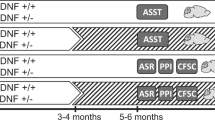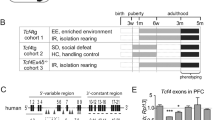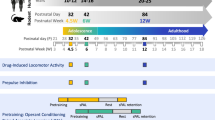Abstract
Phospholipase C-β1 (PLC-β1) is a rate-limiting enzyme implicated in postnatal-cortical development and neuronal plasticity. PLC-β1 transduces intracellular signals from specific muscarinic, glutamate and serotonin receptors, all of which have been implicated in the pathogenesis of schizophrenia. Here, we present data to show that PLC-β1 knockout mice display locomotor hyperactivity, sensorimotor gating deficits as well as cognitive impairment. These changes in behavior are regarded as endophenotypes homologous to schizophrenia-like symptoms in rodents. Importantly, the locomotor hyperactivity and sensorimotor gating deficits in PLC-β1 knockout mice are subject to beneficial modulation by environmental enrichment. Furthermore, clozapine but not haloperidol (atypical and typical antipsychotics, respectively) rescues the sensorimotor gating deficit in these animals, suggesting selective predictive validity. We also demonstrate a relationship between the beneficial effects of environmental enrichment and levels of M1/M4 muscarinic acetylcholine receptor binding in the neocortex and hippocampus. Thus we have demonstrated a novel mouse model, displaying disruption of multiple postsynaptic signals implicated in the pathogenesis of schizophrenia, a relevant behavioral phenotype and associated gene–environment interactions.
This is a preview of subscription content, access via your institution
Access options
Subscribe to this journal
Receive 12 print issues and online access
$259.00 per year
only $21.58 per issue
Buy this article
- Purchase on Springer Link
- Instant access to full article PDF
Prices may be subject to local taxes which are calculated during checkout







Similar content being viewed by others
References
Harrison PJ . The neuropathology of schizophrenia. A critical review of the data and their interpretation. Brain 1999; 122 (Part 4): 593–624.
Lewis DA, Moghaddam B . Cognitive dysfunction in schizophrenia: convergence of gamma-aminobutyric acid and glutamate alterations. Arch Neurol 2006; 63: 1372–1376.
Hannan AJ, Blakemore C, Katsnelson A, Vitalis T, Huber KM, Bear M et al. PLC-beta1, activated via mGluRs, mediates activity-dependent differentiation in cerebral cortex. Nat Neurosci 2001; 4: 282–288.
Hannan AJ, Kind PC, Blakemore C . Phospholipase C-beta1 expression correlates with neuronal differentiation and synaptic plasticity in rat somatosensory cortex. Neuropharmacology 1998; 37: 593–605.
Kind PC, Kelly GM, Fryer HJ, Blakemore C, Hockfield S . Phospholipase C-beta1 is present in the botrysome, an intermediate compartment-like organelle, and is regulated by visual experience in cat visual cortex. J Neurosci 1997; 17: 1471–1480.
Pacheco MA, Jope RS . Phosphoinositide signaling in human brain. Prog Neurobiol 1996; 50: 255–273.
Exton JH . Regulation of phosphoinositide phospholipases by hormones, neurotransmitters, and other agonists linked to G proteins. Annu Rev Pharmacol Toxicol 1996; 36: 481–509.
Nishizuka Y . The molecular heterogeneity of protein kinase C and its implications for cellular regulation. Nature 1988; 334: 661–665.
Kim D, Jun KS, Lee SB, Kang NG, Min DS, Kim YH et al. Phospholipase C isozymes selectively couple to specific neurotransmitter receptors. Nature 1997; 389: 290–293.
Salles J, Wallace MA, Fain JN . Modulation of the phospholipase C activity in rat brain cortical membranes by simultaneous activation of distinct monoaminergic and cholinergic muscarinic receptors. Brain Res Mol Brain Res 1993; 20: 111–117.
Jose PA, Yu PY, Yamaguchi I, Eisner GM, Mouradian MM, Felder CC et al. Dopamine D1 receptor regulation of phospholipase C. Hypertens Res 1995; 18 (Suppl 1): S39–S42.
Wallace MA, Claro E . A novel role for dopamine: inhibition of muscarinic cholinergic-stimulated phosphoinositide hydrolysis in rat brain cortical membranes. Neurosci Lett 1990; 110: 155–161.
Carter HR, Wallace MA, Fain JN . Activation of phospholipase C in rabbit brain membranes by carbachol in the presence of GTP gamma S; effects of biological detergents. Biochim Biophys Acta 1990; 1054: 129–135.
Harrison PJ, Weinberger DR . Schizophrenia genes, gene expression, and neuropathology: on the matter of their convergence. Mol Psychiatry 2005; 10: 40–68; image 5.
Seeman P, Chau-Wong M, Tedesco J, Wong K . Brain receptors for antipsychotic drugs and dopamine: direct binding assays. Proc Natl Acad Sci USA 1975; 72: 4376–4380.
Creese I, Burt DR, Snyder SH . Dopamine receptor binding predicts clinical and pharmacological potencies of antischizophrenic drugs. Science 1976; 192: 481–483.
Lopez-Figueroa AL, Norton CS, Lopez-Figueroa MO, Armellini-Dodel D, Burke S, Akil H et al. Serotonin 5-HT1A, 5-HT1B, and 5-HT2A receptor mRNA expression in subjects with major depression, bipolar disorder, and schizophrenia. Biol Psychiatry 2004; 55: 225–233.
Scarr E, Copolov DL, Dean B . A proposed pathological model in the hippocampus of subjects with schizophrenia. Clin Exp Pharmacol Physiol 2001; 28: 70–73.
Watanabe S, Nishikawa T, Takashima M, Toru M . Increased muscarinic cholinergic receptors in prefrontal cortices of medicated schizophrenics. Life Sci 1983; 33: 2187–2196.
Bennett Jr JP, Enna SJ, Bylund DB, Gillin JC, Wyatt RJ, Snyder SH . Neurotransmitter receptors in frontal cortex of schizophrenics. Arch Gen Psychiatry 1979; 36: 927–934.
Dean B, Crook JM, Opeskin K, Hill C, Keks N, Copolov DL . The density of muscarinic M1 receptors is decreased in the caudate-putamen of subjects with schizophrenia. Mol Psychiatry 1996; 1: 54–58.
Raedler TJ, Bymaster FP, Tandon R, Copolov D, Dean B . Towards a muscarinic hypothesis of schizophrenia. Mol Psychiatry 2006; 12: 232–246.
Noga JT, Hyde TM, Herman MM, Spurney CF, Bigelow LB, Weinberger DR et al. Glutamate receptors in the postmortem striatum of schizophrenic, suicide, and control brains. Synapse 1997; 27: 168–176.
Nudmamud-Thanoi S, Reynolds GP . The NR1 subunit of the glutamate/NMDA receptor in the superior temporal cortex in schizophrenia and affective disorders. Neurosci Lett 2004; 372: 173–177.
Ohnuma T, Augood SJ, Arai H, McKenna PJ, Emson PC . Expression of the human excitatory amino acid transporter 2 and metabotropic glutamate receptors 3 and 5 in the prefrontal cortex from normal individuals and patients with schizophrenia. Brain Res Mol Brain Res 1998; 56: 207–217.
Lin XH, Kitamura N, Hashimoto T, Shirakawa O, Maeda K . Opposite changes in phosphoinositide-specific phospholipase C immunoreactivity in the left prefrontal and superior temporal cortex of patients with chronic schizophrenia. Biol Psychiatry 1999; 46: 1665–1671.
Spires TL, Molnar Z, Kind PC, Cordery PM, Upton AL, Blakemore C et al. Activity-dependent regulation of synapse and dendritic spine morphology in developing barrel cortex requires phospholipase C-beta1 signalling. Cereb Cortex 2005; 15: 385–393.
Bohm D, Schwegler H, Kotthaus L, Nayernia K, Rickmann M, Kohler M et al. Disruption of PLC-beta 1-mediated signal transduction in mutant mice causes age-dependent hippocampal mossy fiber sprouting and neurodegeneration. Mol Cell Neurosci 2002; 21: 584–601.
Shin J, Kim D, Bianchi R, Wong RK, Shin HS . Genetic dissection of theta rhythm heterogeneity in mice. Proc Natl Acad Sci USA 2005; 102: 18165–18170.
van den Buuse M, Garner B, Gogos A, Kusljic S . Importance of animal models in schizophrenia research. Aust N Z J Psychiatry 2005; 39: 550–557.
Geyer MA, McIlwain KL, Paylor R . Mouse genetic models for prepulse inhibition: an early review. Mol Psychiatry 2002; 7: 1039–1053.
Koh PO, Bergson C, Undie AS, Goldman-Rakic PS, Lidow MS . Up-regulation of the D1 dopamine receptor-interacting protein, calcyon, in patients with schizophrenia. Arch Gen Psychiatry 2003; 60: 311–319.
Suhara T, Okubo Y, Yasuno F, Sudo Y, Inoue M, Ichimiya T et al. Decreased dopamine D2 receptor binding in the anterior cingulate cortex in schizophrenia. Arch Gen Psychiatry 2002; 59: 25–30.
Mita T, Hanada S, Nishino N, Kuno T, Nakai H, Yamadori T et al. Decreased serotonin S2 and increased dopamine D2 receptors in chronic schizophrenics. Biol Psychiatry 1986; 21: 1407–1414.
Dean B, Hayes W, Opeskin K, Naylor L, Pavey G, Hill C et al. Serotonin2 receptors and the serotonin transporter in the schizophrenic brain. Behav Brain Res 1996; 73: 169–175.
Whitaker PM, Crow TJ, Ferrier IN . Tritiated LSD binding in frontal cortex in schizophrenia. Arch Gen Psychiatry 1981; 38: 278–280.
Dean B, McLeod M, Keriakous D, McKenzie J, Scarr E . Decreased muscarinic1 receptors in the dorsolateral prefrontal cortex of subjects with schizophrenia. Mol Psychiatry 2002; 7: 1083–1091.
Raedler TJ . Comparison of the in-vivo muscarinic cholinergic receptor availability in patients treated with clozapine and olanzapine. Int J Neuropsychopharmacol 2007; 10: 275–280.
van den Buuse M, Martin S, Brosda J, Leck KJ, Matthaei KI, Hendry I . Enhanced effect of dopaminergic stimulation on prepulse inhibition in mice deficient in the alpha subunit of G(z). Psychopharmacology (Berl) 2005; 183: 358–367.
Ouagazzal AM, Jenck F, Moreau JL . Drug-induced potentiation of prepulse inhibition of acoustic startle reflex in mice: a model for detecting antipsychotic activity? Psychopharmacology (Berl) 2001; 156: 273–283.
Paxinos G, Franklin KJ . The Mouse Brain in Stereotaxic Coordinates. Academic Press: San Diego, CA, USA, 2001.
Bannerman DM, Yee BK, Good MA, Heupel MJ, Iversen SD, Rawlins JN . Double dissociation of function within the hippocampus: a comparison of dorsal, ventral, and complete hippocampal cytotoxic lesions. Behav Neurosci 1999; 113: 1170–1188.
Moser E, Moser MB, Andersen P . Spatial learning impairment parallels the magnitude of dorsal hippocampal lesions, but is hardly present following ventral lesions. J Neurosci 1993; 13: 3916–3925.
Bast T, Feldon J . Hippocampal modulation of sensorimotor processes. Prog Neurobiol 2003; 70: 319–345.
Starr MS, Summerhayes M . Multifocal brain sites for apomorphine-induced circling and other stereotyped motor behaviour in the 6-hydroxydopamine-lesioned rat. Neurosci Lett 1982; 34: 277–282.
Swerdlow NR, Geyer MA, Braff DL . Neural circuit regulation of prepulse inhibition of startle in the rat: current knowledge and future challenges. Psychopharmacology (Berl) 2001; 156: 194–215.
Mickley GA, Ferguson JL, Nemeth TJ, Mulvihill MA, Alderks CE . Spontaneous perseverative turning in rats with radiation-induced hippocampal damage. Behav Neurosci 1989; 103: 722–730.
McOmish CE, Howard M, van den Buuse M, Hannan AJ . Gene–environment interactions regulate a developmental signaling pathway involving PLC-ß1 and RGS4 in the cerebral cortex. Mech Dev 2005; 122: S115.
Jones CK, Shannon HE . Effects of scopolamine in comparison with apomorphine and phencyclidine on prepulse inhibition in rats. Eur J Pharmacol 2000; 391: 105–112.
Jones CK, Shannon HE . Muscarinic cholinergic modulation of prepulse inhibition of the acoustic startle reflex. J Pharmacol Exp Ther 2000; 294: 1017–1023.
Miyakawa T, Yamada M, Duttaroy A, Wess J . Hyperactivity and intact hippocampus-dependent learning in mice lacking the M1 muscarinic acetylcholine receptor. J Neurosci 2001; 21: 5239–5250.
Jones CK, Eberle EL, Shaw DB, McKinzie DL, Shannon HE . Pharmacologic interactions between the muscarinic cholinergic and dopaminergic systems in the modulation of prepulse inhibition in rats. J Pharmacol Exp Ther 2005; 312: 1055–1063.
Gerber DJ, Sotnikova TD, Gainetdinov RR, Huang SY, Caron MG, Tonegawa S . Hyperactivity, elevated dopaminergic transmission, and response to amphetamine in M1 muscarinic acetylcholine receptor-deficient mice. Proc Natl Acad Sci USA 2001; 98: 15312–15317.
Roth RH, Bunney BS . Interaction of cholinergic neurons with other chemically defined neuronal systems in the CNS. In: Goldberg AM, Hanin I (eds). Biology of Cholinergic Function. Raven: New York, 1976, pp 379–394.
Zhong P, Gu Z, Wang X, Jiang H, Feng J, Yan Z . Impaired modulation of GABAergic transmission by muscarinic receptors in a mouse transgenic model of Alzheimer's disease. J Biol Chem 2003; 278: 26888–26896.
Janssen PA . The pharmacology of haloperidol. Int J Neuropsychiatry 1967; 3 (Suppl 1): 10–18.
Kudo S, Ishizaki T . Pharmacokinetics of haloperidol: an update. Clin Pharmacokinet 1999; 37: 435–456.
Brunello N, Masotto C, Steardo L, Markstein R, Racagni G . New insights into the biology of schizophrenia through the mechanism of action of clozapine. Neuropsychopharmacology 1995; 13: 177–213.
Bolden C, Cusack B, Richelson E . Clozapine is a potent and selective muscarinic antagonist at the five cloned human muscarinic acetylcholine receptors expressed in CHO-K1 cells. Eur J Pharmacol 1991; 192: 205–206.
Ereshefsky L, Watanabe MD, Tran-Johnson TK . Clozapine: an atypical antipsychotic agent. Clin Pharm 1989; 8: 691–709.
Baldessarini RJ, Huston-Lyons D, Campbell A, Marsh E, Cohen BM . Do central antiadrenergic actions contribute to the atypical properties of clozapine? Br J Psychiatry Suppl 1992; 12–16.
Richelson E, Souder T . Binding of antipsychotic drugs to human brain receptors focus on newer generation compounds. Life Sci 2000; 68: 29–39.
Kusljic S, Brosda J, van den Buuse M . Effects of haloperidol and clozapine on sensorimotor gating deficits induced by 5-hydroxytryptamine depletion in the brain. Br J Pharmacol 2006; 147: 800–807.
Swerdlow NR, Geyer MA . Using an animal model of deficient sensorimotor gating to study the pathophysiology and new treatments of schizophrenia. Schizophr Bull 1998; 24: 285–301.
Carlsson A . Neurocircuitries and neurotransmitter interactions in schizophrenia. Int Clin Psychopharmacol 1995; 10 (Suppl 3): 21–28.
Riederer P, Lange KW, Kornhuber J, Danielczyk W . Glutamatergic-dopaminergic balance in the brain. Its importance in motor disorders and schizophrenia. Arzneimittelforschung 1992; 42: 265–268.
Sams-Dodd F . A test of the predictive validity of animal models of schizophrenia based on phencyclidine and D-amphetamine. Neuropsychopharmacology 1998; 18: 293–304.
Park S, Holzman PS . Schizophrenics show spatial working memory deficits. Arch Gen Psychiatry 1992; 49: 975–982.
Fleming K, Goldberg TE, Binks S, Randolph C, Gold JM, Weinberger DR . Visuospatial working memory in patients with schizophrenia. Biol Psychiatry 1997; 41: 43–49.
Carter C, Robertson L, Nordahl T, Chaderjian M, Kraft L, O'Shora-Celaya L . Spatial working memory deficits and their relationship to negative symptoms in unmedicated schizophrenia patients. Biol Psychiatry 1996; 40: 930–932.
Braff DL, Grillon C, Geyer MA . Gating and habituation of the startle reflex in schizophrenic patients. Arch Gen Psychiatry 1992; 49: 206–215.
Braff DL, Geyer MA . Sensorimotor gating and schizophrenia. Human and animal model studies. Arch Gen Psychiatry 1990; 47: 181–188.
Acknowledgements
We thank L Gray, J Nithianantharajah and C Hannan for comments on manuscript drafts. This work was supported by NHMRC project grants and an RD Wright award (AJH). AJH currently holds a Pfizer Australia Senior Research Fellowship. BD is an NHMRC Senior Research Fellow. ES is the Ronald Griffith Schizophrenia Research Fellow. Funding was also provided by Trust Company Australia (CEM).
Author information
Authors and Affiliations
Corresponding author
Rights and permissions
About this article
Cite this article
McOmish, C., Burrows, E., Howard, M. et al. Phospholipase C-β1 knockout mice exhibit endophenotypes modeling schizophrenia which are rescued by environmental enrichment and clozapine administration. Mol Psychiatry 13, 661–672 (2008). https://doi.org/10.1038/sj.mp.4002046
Received:
Revised:
Accepted:
Published:
Issue Date:
DOI: https://doi.org/10.1038/sj.mp.4002046
Keywords
This article is cited by
-
Isoform specific differences in phospholipase C beta 1 expression in the prefrontal cortex in schizophrenia and suicide
npj Schizophrenia (2017)
-
Adult Neurogenesis and Mental Illness
Neuropsychopharmacology (2015)
-
Disrupted-in-schizophrenia-1 (DISC1) Regulates Endoplasmic Reticulum Calcium Dynamics
Scientific Reports (2015)
-
Environmental Enrichment Ameliorates Behavioral Impairments Modeling Schizophrenia in Mice Lacking Metabotropic Glutamate Receptor 5
Neuropsychopharmacology (2015)
-
Postnatal MK-801 treatment of female rats impairs acquisition of working memory, but not reference memory in an eight-arm radial maze; no beneficial effects of enriched environment
Psychopharmacology (2015)



